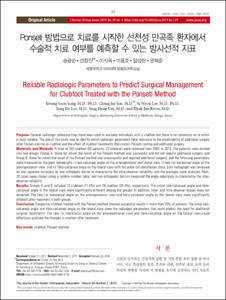KUMEL Repository
1. Journal Papers (연구논문)
1. School of Medicine (의과대학)
Dept. of Orthopedic Surgery (정형외과학)
Ponseti 방법으로 치료를 시작한 선천성 만곡족 환자에서 수술적 치료 여부를 예측할 수 있는 방사선적 지표
- Keimyung Author(s)
- Song, Kwang Soon; Lee, Si Wook
- Department
- Dept. of Orthopedic Surgery (정형외과학)
- Journal Title
- 대한정형외과학회지
- Issued Date
- 2019
- Volume
- 54
- Issue
- 1
- Keyword
- 선천성 만곡족; Ponseti 방법; clubfoot; Ponseti method
- Abstract
- Purpose:
Several radiologic reference lines have been used to evaluate individuals with a clubfoot but there is no consensus as to which is most reliable. The aim of this study was to identify which radiologic parameters have relevance to the predictability of additional surgery after Ponseti casting on clubfoot and the effect of clubfoot treatments that contain Ponseti casting and additional surgery.
Materials and Methods:
A total of 102 clubfeet (65 patients, 37 bilateral) were reviewed from 2005 to 2013. The patients were divided into two groups (Group A, those for whom the result of the Ponseti method was successful and did not require additional surgery; and Group B, those for whom the result of the Ponseti method was unsuccessful and required additional surgery), and the following parameters were measured on the plain radiographs: i) talo-calcaneal angle on the anteroposterior and lateral view, ii) talo-1st metatarsal angle on the anteroposterior view, and iii) Tibio-calcaneal angle on the lateral view with the ankle full-dorsiflexion state. Each radiograph was reviewed on two separate occasions by one orthopedic doctor to characterize the intra-observer reliability, and the averages were analyzed. Next, 20 cases were chosen using a random number table, and two orthopedic doctors measured the angle separately to characterize the inter-observer reliability.
Results:
Groups A and B included 73 clubfeet (71.6%) and 29 clubfeet (28.4%), respectively. The initial talo-calcaneal angle and tibio-calcaneal angle in the lateral view were significantly different among the groups. In addition, inter- and intra-observer biases were not detected. The talo-1st metatarsal angle on the anteroposterior view and tibio-calcaneal angle on the lateral view were significantly different after treatment in both groups.
Conclusion:
Congenital clubfeet treated with the Ponseti method showed successful results in more than 70% of patients. The initial talo-calcaneal angle and tibio-calcaneal angle on the lateral view were the radiologic parameters that could predict the need for additional surgical treatments. The talo-1st metatarsal angle on the anteroposterior view and tibio-calcaneal angle on the lateral view could effectively evaluate the changes in clubfoot after treatment.
목적:
선천성 만곡족 환자에서 Ponseti 방법으로 치료한 환자들에서 잔여 혹은 재발 변형에 대한 수술적 치료의 필요성을 예측하고 치료 결과를 평가하는 데 있어 어떤 방사선적 기준선이 유용할지에 대하여 연구하고자 하였다.
대상 및 방법:
2005년부터 2013년까지 Ponseti 방법으로 치료를 시작한 환자 102족(65명, 양측성 37명)을 연구대상으로 했다. 환자는 수술 여부에 따라 두 군(A군: Ponseti 방법의 결과가 성공적이어서 추가 수술을 시행하지 않은 군, B군: Ponseti 방법의 결과가 만족스럽지 않아 수술을 시행한 군)으로 나누었고, 두 군의 방사선적 족부 변형 상태 비교를 위해 전후면 및 측면 거종간 각, 전후면 거골-제1중족골간 각, 발목 완전 배굴 상태에서의 측면 경종간 각을 측정하였다. 각 방사선 사진은 관찰자 내 신뢰도를 평가하기 위해 한 정형외과 의사가 두 번씩 검토한 후 평균을 분석하였으며 관찰자 간 신뢰도를 평가하기 위해 난수표를 통해 20족을 선정하여 각도를 측정하였다.
결과:
A군은 73족(71.6 %)이었고, B군은 29족(28.4%)이었다. 초기 방사선 소견상 측면 거종간 각 및 측면 경종간 각에서 두 군 간 의미 있는 차이가 있었고, 관찰자 간 및 관찰자 내 신뢰도의 편향은 관찰되지 않았다. 전후면 거골-제1중족골간 각 및 측면 경종간 각은 양군에서 모두 치료 전후로 유의한 차이가 있었다.
결론:
선천성 만곡족의 치료에서 Ponseti 방법으로 치료한 후 70% 이상의 환자에서 만족스러운 결과를 보였다. 방사선적으로 초기 측면 거종간 각 및 측면 경종간 각을 통해 수술적 치료 여부를 예측할 수 있었고, 전후면 거골-제1중족골간 각 및 측면 경종간 각을 통해 치료 후 선천성 만곡족의 변화 정도를 평가할 수 있었다.
- Alternative Title
- Reliable Radiologic Parameters to Predict Surgical Management for Clubfoot Treated with the Ponseti Method
- Publisher
- School of Medicine (의과대학)
- Citation
- Kwang Soon Song et al. (2019). Ponseti 방법으로 치료를 시작한 선천성 만곡족 환자에서 수술적 치료 여부를 예측할 수 있는 방사선적 지표. 대한정형외과학회지, 54(1), 59–66. doi: 10.4055/jkoa.2019.54.1.59
- Type
- Article
- ISSN
- 2005-8918
- Source
- https://jkoa.org/search.php?where=aview&id=10.4055/jkoa.2019.54.1.59&code=0043JKOA&vmode=FULL
- Appears in Collections:
- 1. School of Medicine (의과대학) > Dept. of Orthopedic Surgery (정형외과학)
- 파일 목록
-
-
Download
 oak-2019-0209.pdf
기타 데이터 / 973.94 kB / Adobe PDF
oak-2019-0209.pdf
기타 데이터 / 973.94 kB / Adobe PDF
-
Items in Repository are protected by copyright, with all rights reserved, unless otherwise indicated.